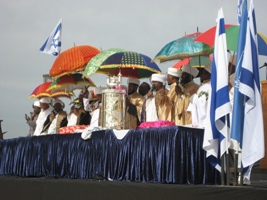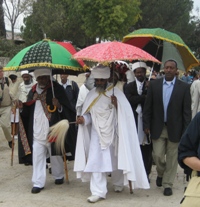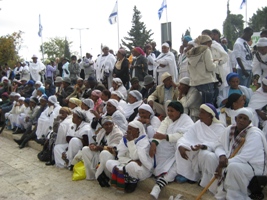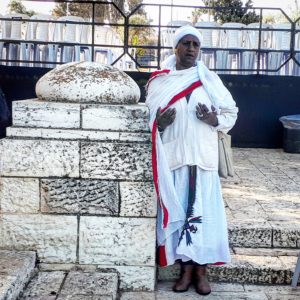Everybody is drawn by Jerusalem. Every Jerusalem resident know that when he sees a new flag raised in the city he’d better stay home. You don’t want to walk or drive the streets of the city when some foreign diplomat causes traffic jams that result in angry people who are late for work. In these days, Jerusalem citizens long only for the peaceful routine, but today I want to write about a different event. This event, though involving tens of thousands of people did not cause any unusual traffic problems. It was a festival that gave us all a feeling of spiritual elevation. None of us wanted it to be finished.
Once a year, on the 29th day of the Hebrew month Cheshvan, the members of the Beta Israel congregation ( Jews coming from Ethiopia ) gather in the ridge of Armon Hanatziv in Jerusalem. They come from all over Israel to celebrate the Sigd festival. The festival takes place fifty days after Yom kipur (day of atonement) and has four important themes: the yearning for the land of Zion, the commemoration of the day the ten commandments were given to the people of Israel, the commemoration of the renewal of the covenant by Ezra during the return to Zion from the Babylonian Exile in the 6th century BC and a reminder of the importance of keeping Mitzvot. In Ethiopia this festival was of high importance to the community. People used to fast, walk long distances and meeting old acquaintances. Today, the Sigd has gone through a some changes, but the importance of social gathering is still noticed. I’ve been to quite a few ceremonies in Jerusalem. Some involved tens of thousands of people, others only a few. Some were Christian ceremonies, some Muslim and some Jewish, but I never experienced such ceremony as the one held during the Sigd festival. It was very simple: on a stage facing the wonderful view of the Sherover promenade, stood the elders of Beta Israel – the Kessim. They held holy bibles in their hands and sang long monotonous liturgical poems called Piyutim while sheltered by numerous colorful umbrellas. These liturgical poems last for hours and the huge crowd is fascinated by them:
“And Holy Zion thus climbs the mountain, And Saved Zion thus climbs the mountain Lift up your eyes round about, and see: they all are gathered together, All your sons come from far…”
This Chant is only one out of many others. Part of the crowd listen attentively to every word that is spoken or sang on stage, others focus on the social gathering. I could feel the pride in the air – that is a festival which is unique to the Ethiopian community, it goes back a long time but today it becomes a well noted and appreciated sign of this culture in the modern Israeli society. Not long ago, in the Israeli Knesset (the Israeli Parliament), a new law was legislated. It recognizes the Sigd festival to be an official holyday in the Jewish state. As I was walking around I felt this holy festival had also an important social message. It was as if the crowd was saying “We also have something to contribute to the Israeli society”, “Our culture is both ancient and uncompromising”. Not one person was bowing his head; no one was looking for excuses for what he is. I met people who are proud at their culture. A few small talks showed me other aspects: A young man from “Hashomer Hatzair” youth movement that came from Kiryat Moshe neighborhood in the city of Rehovot, reminded me the difficulties Ethiopian university graduates encounter while trying to find a decent job, Tomer, an old friend of mine spoke of the discrimination he encountered and the racism that you can find in many schools in the city of Petach Tikva. That moment, all those words sounded like relevant criticism, which is a part of the social campaign the Ethiopian community is conducting. These days it feels like they are really going to win.
“Hear us O Lord, Hear us, Hear us O Lord, Hear us Lord, our God. As we pray to you, as we call upon you, as we cry for you, You who loves us from above, from your dwelling place, Hear us…”
The Kessim continued praying, the elders dressed in their traditional gowns listened, and I was looking for the young generation. I didn’t have to look far away. Along the Sherover promenade I could see a few tents that were raised buy the people of the Israeli youth movements. The youngsters sat their talking and learning about the Sigd festival and about the issues of immigration absorption. The youth leaders from all movements cooperated and created a wonderful educational open space for the children and youth and they came, sat and learned and just mingled. I felt really festive and cheerful. A few steps further I met groups of soldiers from various army forces – they were exchanging opinions and experience. At the corner of my eye, under the bush I could see the couples ( many of them were half Ethiopian and half “farangies” – the Ethiopian word for white people) they were looking for a moment together. It was really heartwarming.
It is hard to avoid the comparison of the Sigd festival to the Mimuna. The Mimuna festival has a similar importance in revealing the beauty of a unique Jewish culture – The Moroccan culture . A culture that was left behind for many years by the Israeli society. The Mimuna festival, just like the sigd helped the Moroccans hold their head up high and preserve their magnificent culture while becoming integrated in the Israeli society. As I already had a few opportunities to participate in the Mimuna festival I can only find one fundamental difference between the two festivals. I feel that the Mimuna festivals became more of a nostalgic celebration and the Sigd still feels like an outspoken criticism that relates to the social state of the Ethiopian community in Israel. The last significant Moroccan Aliya happened back in the 60’s. Today, a new group of newcomers from the 90’s are working hard to take their rightful place in the cultural Israeli Mosaic, A mosaic second to none all over the world. Now, are you still wandering why we didn’t want the festival to end?



